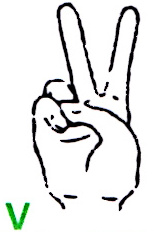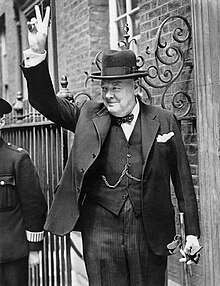Victory sign

The victory sign ( English victory , victory ') is a hand gesture in which the index and middle fingers outstretched in a "V" while the ring finger and the little finger remain confiscated. The thumb is placed over the two fingers and the palm of the hand points away from the person performing.

The finger alphabet for the deaf or hard of hearing represents the letter V in an identical way.
meaning
The gesture has very different meanings internationally. In Germany and most western countries it is often understood as a sign of victory. This corresponds to the interpretation that the "V" formed by the index and middle finger stands for the English victory .
Other meanings that are also common are the number 2 or rabbit ears (shown for fun on photos behind the heads of people standing next to them to annoy them). It is also understood as a peace sign.
If the palm of the hand or, if the hand is held to the side of the body, the little finger side points towards the performer, or with the back of the hand away from the performer, it has a seriously offensive meaning in Great Britain, Ireland, Australia, New Zealand and South Africa, roughly comparable to that Finger . In the offensive form, the index and middle fingers do not have to be fully extended, but are often shown slightly curved. The "V" shape does not have to be so pronounced, you can keep both fingers together. According to the folklore dictionary by Jacqueline Simpson and Steve Roud from 2000, the V-sign (with the back of the hand facing the opposite) was the typical British insult gesture for most of the 20th century, but has lost its ability to insult in recent years.
Even so, when making hand signals for the number two, most Britons would still be careful enough to point the palm of their hands towards the viewer. Simpson and Roud still consider the origin of the horned symbol to be possible, although this does not have the aggressive power of the V symbol by far and is traditionally carried out with the little finger and ring finger. The American counterpart (single middle finger) has only been known to the British from the media since the 1960s.
In East Asian countries such as Japan , South Korea and Taiwan , the gesture is also very often made on photos or film recordings. The meaning here is roughly happy , so it should just underline a smile. The historical connotations from the Second World War and the Cold War as well as the insulting variation with an upside-down hand are mostly unknown.
Held to the right temple, it is the formal greeting of the wolves, the youngest age group of boy scouts . The outstretched fingers wolf ears and the thumb in front of the little one and the ring finger symbolize the motto: the strong protects the weak.
history

The first documented documentation of the offensive V mark was in Britain in 1901, when workers outside Parkgate ironworks in Rotherham used the gesture (captured on film) to indicate that they did not want to be filmed.
The great popularity of the (positive) victory sign during World War II probably originated in Belgium: In a radio address on 14 January 1941 in the BBC, former Belgian Minister of Justice Victor de Laveleye called on his countrymen, the V spread. Because in addition to the already mentioned reference to the English word victory , it is also the first letter of the French word Victoire and the Dutch word Vrijheid . The BBC supported the distribution in Europe through its “V for Victory” campaign, in which the Morse code for “V” ( ••• - ) was used as a jingle. The Morse code for “V” also corresponds to the head motif of Beethoven's 5th Symphony (“Ta Ta Ta Taaa”), which the BBC also used as a distinguishing feature of its program with a certain irony (Beethoven was German and the motif was the “fate motif”) radiated to occupied countries. The use of the gesture quickly spread across Europe. In the same year, Winston Churchill took up the "V for Victory" campaign and from then on used the V mark in public appearances.
And the Germans also used the “V” symbol, as shown in the adjacent picture from 1941 of Stortinget in occupied Norway .
In 1941, the British occultist Aleister Crowley claimed the deliberate introduction of the V symbol as a counter-symbol to the Nazi-German swastika: He pointed out that his publication Magick , published in 1913, showed both symbols on a picture board.
After the Second World War, the gesture can be found among other things as a distinctive gesture by US President Richard Nixon .
During protests against the Vietnam and other wars as well as in circles of the so-called counterculture , the V-sign became a common gesture at greetings, rallies and in photos. The combination of the gesture used by hippies with the expression peace ( English peace 'or' peace ') or "love and peace" (English "love and peace") as well as the use on anti-war demonstrations emphasized the peace advocates Meaning of the V sign.
There are various explanations for the appearance of the V mark in Japanese pop culture in the early 1970s. This largely depoliticized variant of the Victory gesture spread throughout East Asia and is found primarily in Japan , South Korea , Taiwan and Hong Kong .
Another variant of meaning emerged in England in 1997 through the Spice Girls as a symbol for girl power .
Popular legend attributes the sign to English archers in the Hundred Years War, but there is no evidence for this. After that it was a defiant gesture of the English archers that they still had the index and middle fingers to handle the bow. According to Jean de Wavrin's chronicle, the French cut off the fingers of the right hand from captured archers , but three, not two, to make sure that they were no longer bowing.
Unicode
Unicode defines the victory character with U + 270C ( ✌ ).
Web links
Individual evidence
- ↑ Eric Patridge, Tom Dalzell, Terry Victor. (2008) The Concise New Partridge Dictionary of Slang and Unconventional English , Routledge, p. 683. ISBN 0-203-96211-7 .
- ↑ a b c Jacqueline Simpson, Steve Roud; A Dictionary of English Folklore, Oxford UP 2000, V-sign , p. 376. The quintessential British offensive gesture for most of the 20th century .
- ↑ a b Cf. contribution by the East Asia Institute of the Ludwigshafen University of Applied Sciences on the Asian variant of the V-gesture. Retrieved February 11, 2013.
- ↑ See The V sign ( Memento of October 18, 2008 in the Internet Archive ), article on the ICONS website . A portrait of England ( Memento from June 23, 2007 in the Internet Archive ). Retrieved February 11, 2013.
- ^ The BBC at War - Overseas programming . In: bbc.co.uk . Accessed December 7, 2015.
- ^ Newswatch 1940s . In: news.bbc.co.uk . Retrieved February 11, 2013.
- ↑ The V sign at BBC's H2G2 website . BBC.co.uk. November 1, 1990. Retrieved February 11, 2013.
- ^ This Day in Quotes . Retrieved February 11, 2013.
- ↑ Kaczynski, Richard. Perdurabo: The Life of Aleister Crowley . North Atlantic Books, 2010, p. 511.
- ↑ The creolization of the "V sign". March 8, 2011, accessed December 7, 2015 .
- ↑ a b See The Japanese Version (the Sign of Peace) ( Memento from June 21, 2008 in the Internet Archive ) Article on the ICONS website . A portrait of England ( Memento from June 23, 2007 in the Internet Archive ). Retrieved February 11, 2013.
- ↑ BS Historian , July 2, 2007
- ↑ Jacqueline Simpson, Steve Roud, A Dictionary of English Folklore, Oxford UP 2000, p. 376. There is not a shred of evidence to support this unlikely origin . They add, however, that this declaration is also about to become folklore.


